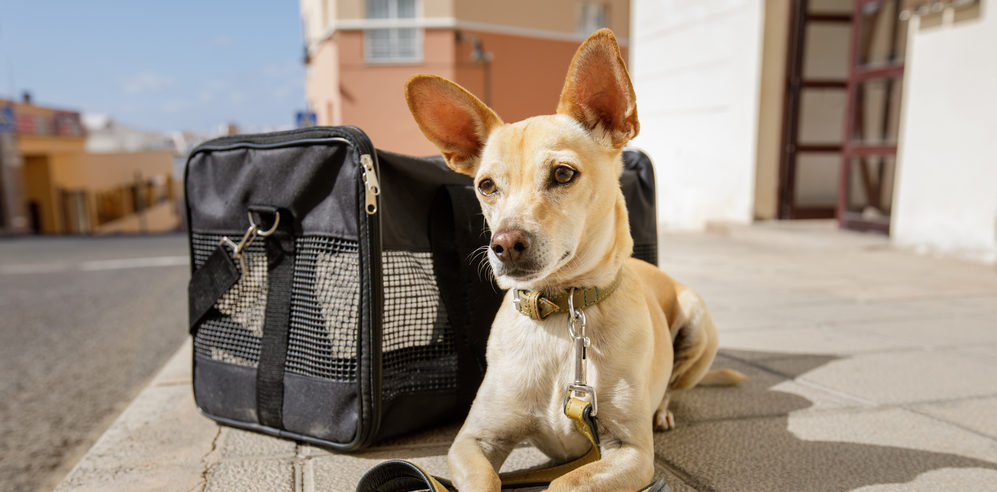You never know when disaster will strike. Each year, hurricanes, wildfires, earthquakes, tornadoes, and other natural disasters cause people to flee their homes in search of safety. In case of a disaster, it’s important to create a plan that takes the safety of pets as well as people into consideration.
A disaster preparedness plan includes steps for before, during, and after the disaster.
If your family needs to shelter in place during a disaster such as a tornado, do not leave pets outdoors. Designate a safe place in your home for your pets, preferably the same area where you’re staying. An interior room without windows is the safest place for pets. If possible, introduce them to this place before a storm or other disaster and make sure there’s a comfortable bed, a favorite toy, and a litter box for cats so they feel safe and at home.
Evacuation Preparation
Do not leave pets behind if you’re evacuated from your home. If it isn’t safe for your family, it’s isn’t safe for your pets. Prepare an evacuation plan:
Identify a family member who is responsible for the pet. This person will get the pet, the food and water, and the disaster pack.
Know of a few safe places for your pets to go if you need to evacuate. This can be a friend or family member’s home in a safe area, a boarding kennel outside the evacuation area, or animal shelters that provide emergency shelter or foster services.
Be familiar with pet-friendly lodging along the evacuation route (keep a list of pet-friendly hotel chains in your disaster pack).
Ask family or friends outside your area if they would be willing to take in you and your pets in the event of an evacuation.
Have a Disaster Pack for Pets
This pack contains emergency rations and necessary gear for pets to shelter in place or evacuate with you. You can add these supplies to the one you have for yourself. Include these essential items:
Food and water. At least one weeks’ worth of water and food for each pet, bowls, and a can opener if needed. It’s also a good idea to have a way to sanitize water, such as tablets or a filtration system; you don’t want your pets drinking from contaminated flood waters, for instance.
Potty supplies. A disaster won’t stop your pet from having to go to the bathroom. For cats, have a litter box, litter scooper, and garbage bags. For dogs you’ll need poop bags and absorbent potty pads.
Sturdy carrier or crate, harness, and leash. These will allow you to transport your cat or dog safely and ensure that they are secure.
Medications. Make sure you have a one- to two-week supply of any medications that have been prescribed for your pets. Other musts:
–A flea and tick preventive. A one-month supply ensures there is no lapse in parasite protection.
–Heartworm preventive. Protecting your pet from heartworm disease is especially important after hurricanes and flooding. If your pet is on oral heartworm medication, make sure you have a one-month supply on hand.
Current photo and description of pets. In case your pet is lost during the chaos, these items will help reunite you with them. You can use them to make flyers or post them on social media to spread the word.
Copies of veterinary records, including vaccinations. Since your veterinary clinic may also be affected by the evacuation, bring your pet’s records with you. That way you’ll be prepared if you need to seek veterinary attention for your pet.
Temporary identification tags. Write the address where you’re staying during the evacuation on these tags and attach to pets’ collars.
More Ways to be Prepared
Permanent identification. Microchips increase the likelihood that your pet will be returned to you. If your pet loses the collar with tags on it, a scan for a microchip gives quick access to your contact information. Keep your contact information up to date with the registry company and ensure that the chip is still working (your veterinarian’s office can check this any time you are there with a quick scan).
Know first aid basics. Find and take a pet first aid class. Your local animal shelter or veterinary emergency hospital may offer classes. The Red Cross also offers a short online course and has an app that walks you through giving your pet first aid so you can care for him in an emergency.
Once your plan is created, make sure you have everything in place. Practice the plan so you’re ready to act in the event of a disaster. Practice can make the difference in your ability to act fast when disaster strikes.
Learn more at zoetispetcare.com
This article was reviewed/edited by board-certified veterinary behaviorist Dr. Kenneth Martin and/or veterinary technician specialist in behavior Debbie Martin, LVT.

This article is brought to you in collaboration with our friends at Zoetis Petcare.








